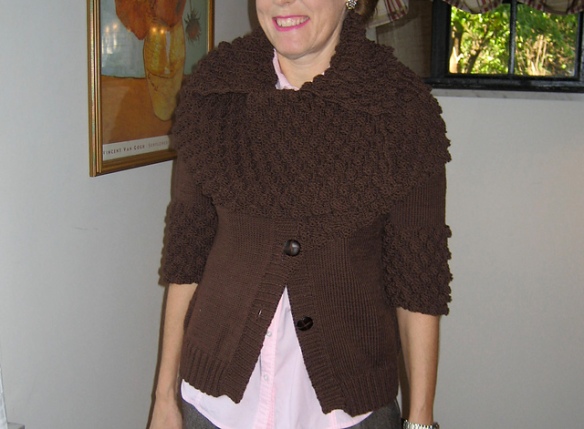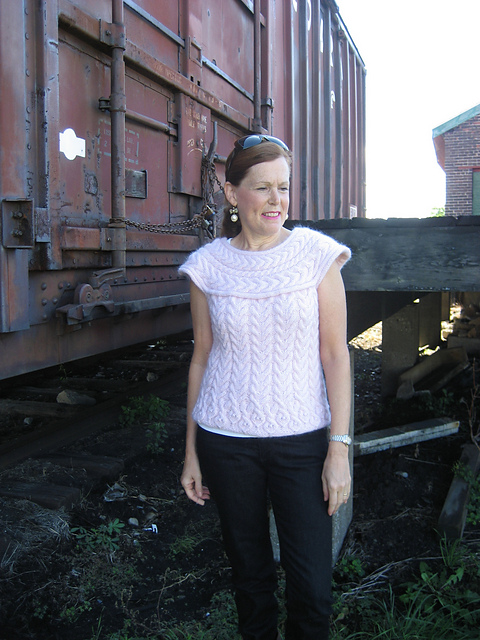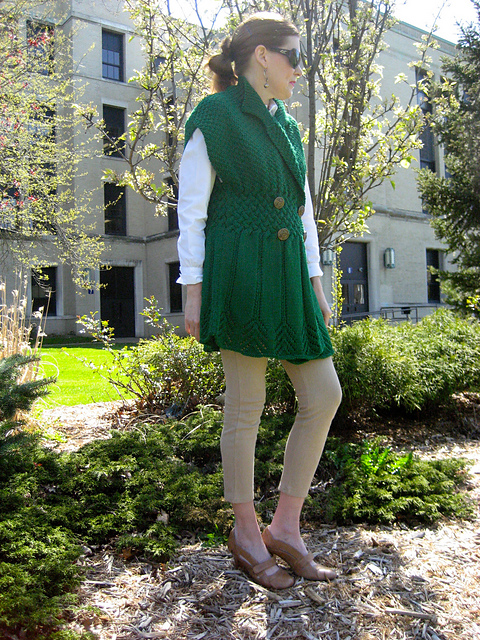Today I am thinking about the direction one knits a sweater. It’s on my mind because I am near finished with a top down knitted cardigan and the process of knitting in that direction is not as familiar to me as knitting in the direction from the bottom to the neckline. Also, I hear knitters exclaiming how they would never consider knitting in the direction that they are not familiar with. I wonder why.
For years, in publications I followed, designers of knitwear wrote directions in a pretty prescribed formula. Typically, for a sweater, after gauges were knitted up and a secure knowledge of stitches to the inch, rows to the inch were known, knitters would be directed to start at the bottom edge of the back section, complete it and set it aside. Then, a knitter would knit one front side, reverse all shaping and knit the other front side and then finish by knitting the sleeves from the cuff up to the cap of the sleeve. I, myself have knitted sweaters in this bottom/up direction for pretty near thirty years. Not until I joined Ravelry and read some of the patterns and comments that were made there did I realize that knitwear designers of more recent times were designing sweaters to be knitted from the top down, starting at the neck’s edge, continuing in a downward direction from the yoke, shoulders, holding live stitches on each side for sleeves, and continuing to the hemline. The idea of knitting in this direction continues to feel different for me, however I am gaining experience in this construction.
From my view, I see these advantages and disadvantages of each method. Here are some overarching comparisons:
On Seams
Top Down – no seams. Bottom Up – One knits in sections, therefore you need to sew them together in the end.
*Seams stabilize a knitted garment and can hide yarn ends by weaving those ends into the seams. While seams stabilize, they add extra work in the end and need to be done neatly for the garment to hang right. This know-how is an extra skill a knitter needs.
On Construction
Top Down – Can try on as you knit as it is knitted in one piece. Bottom Up – Cannot try on as it is knitted in sections as described, above.
On Style
Top Down – Typically are with yokes. Bottom Up – Variety of styles are able to be knitted.
Here are some examples of former projects knitted from the top to the bottom. As I think of their wearability over time, none of my thoughts ever have me thinking about the direction in which I knitted the garment.
 The light pink cabled top clearly has a yoke, and the orange tunic and the light blue hoodie have a very similar construction with raglan style little puffy short sleeves.
The light pink cabled top clearly has a yoke, and the orange tunic and the light blue hoodie have a very similar construction with raglan style little puffy short sleeves.
The below are knitted from the bottom up, a much more natural way for me to think of knitting only because I’ve done so much more of it:
 You can see the variety of necklines, shapes, and styles. Each of these had sections knitted separately, then sewn or crocheted together in the end.
You can see the variety of necklines, shapes, and styles. Each of these had sections knitted separately, then sewn or crocheted together in the end.
Even though I am more comfortable knitting in, what I perceive a more traditional methodology, I am enjoying discovering the advantages of knitting in this this direction. Or any other as our creative minds might allow.





I have seen some bottom-up patterns where the body is knit in one piece, making openings for the armholes. Therefore no seams necessary. One of the other disadvantages of seamed patterns is if you are using a verigated yarn, the yarn patterning won’t match up at the seams. However, after taking MANY finishing classes, I must admit I actually like doing seams!! 😜
LikeLike
When knitting my tapestry dress, I needed more than one dye lot amount. (hand dye lots only come in 10 skein amounts.) I very strategically knitted with the same dye lot both front and back in a pattern so when I crocheted the seams, the same dye lot was at the same spot and lined up perfectly. In looking at my current finished project which has no side seams and feeling the weight and durability of it, as cute as it is, I am wishing it had seams. This has been a really great conversation and I thank you for joining in!
LikeLike
Hey Holly, Beth here, yes I have done a good bit of both, only thing I would add to the conversation is that you can also knit from the bottom up with no seams. So to me the biggest difference is the “trying on” part, as you can also knit “top down” in shapes that do not have yokes. I still do both, no real preference. If you know the size you need to knit to, you can be sure a “bottom up” will fit you fine! But you are right, people develop preferences for most everything about knitting!!!!
LikeLike
Interesting! I don’t know if I’ve ever knitted down/up with no seams and I did wonder about no yoke top/down. Don’t you suppose it’s all about gauge for a successful project in the end? hmmmm…… Of course, it is ok to have preferences, don’t like the negativity factor of the unknown and/or unfamiliar.
LikeLike
I too find it strange when knitters declare they will only knit in one direction (I hear this a lot more with top down) and I think it’s because seaming is seen as an optional skill, more and more. Which I don’t really agree with, since I find that seams give a knit a real professional look, help the garment keep it’s shape, and generally prevents items from creeping up as you wear them. But there is a limit to how much seaming I’ll do- I’ve had a WIP for more than 2 years because it’s knit in 7 pieces and it’s been such a chore to do all that seaming!
LikeLike
I think what bothers me most is the closed-mindedness of people, in general. Not necessarily talking about knitting. When I hear someone say, “no, I don’t do that or no, I won’t do that” it narrows ability, flexibility, but mostly acceptance. If designers are designing with no seams as they think knitters feel those garments are easier to knit, this indeed would promulgate the notion that seaming is an optional skill. If projects with no seams are problematic in the eventual wearing of them, then those designers are doing a disservice offering up patterns that, in the end, may twist, creep up, or otherwise look lousy. I, myself will continue to knit what I want regardless of direction of knitting to keep open-minded and in the mind set of discovery. (My new Spring cardi with no seams is adorable.) Maybe, it depends on the overall design of the garment as to whether seams may or may not be necessary?
LikeLike
All fabulous looks, Holly! I prefer to knit bottom up because of structure provided by the seams. I have taken a couple of classes where the designer teachers have shared that sweaters knitted as a tube with no side seams tend to hang on the bias, which is not a great look. When trying on a top down garment, I like to put the live stitches on a long piece of yarn to avoid dropped stitches. Holly, great thread …. looking forward to reading more comments!
LikeLike
Yes, I can imagine the twisting of a knitted tube without seams as you’ve described. Thank goodness I’ve not experienced that, yet and thank you for the research on this. Happy Knitting!
LikeLike
Also forgot to add: love all the knits shown here. This orange tunic is crazy!! Love it!
LikeLike
hahaha… The orange tunic is fun for sure. Thank you! (and, I think I am settling on the Sundance theme but I’ve had fun perusing about town here on WordPress!)
LikeLiked by 1 person
I also feel more comfortable knitting from the bottom- up. I am currently knitting a top down tee, but I never feel comfortable trying it on as I go. I am always scared I’ll loose stitches on the sleeves. I just hope that it fits, as with my bottom-up sweaters.
LikeLike
and I will admit, I took full advantage of the trying on factor but you are right, I had to pick up dropped stitches.
LikeLiked by 1 person